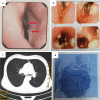Fulminant Laryngeal-tracheobronchial-pulmonary Aspergillosis: A Rare and Fatal Complication in Allogeneic Hematopoietic Stem Cell Transplantation Recipients
- PMID: 28154281
- PMCID: PMC5348461
- DOI: 10.2169/internalmedicine.56.7201
Fulminant Laryngeal-tracheobronchial-pulmonary Aspergillosis: A Rare and Fatal Complication in Allogeneic Hematopoietic Stem Cell Transplantation Recipients
Abstract
A 23-year-old man who had previously undergone allogeneic hematopoietic stem cell transplantation (allo-HSCT) for severe aplastic anemia was diagnosed with invasive laryngeal-tracheobronchial-pulmonary aspergillosis after presenting with a persistent dry cough at six months post-transplantation based on the findings of laryngoscopy and fiberoptic bronchoscopy. A fiberoptic bronchoscope was used to remove the obstructive material from the patient's airway and posaconazole plus caspofungin were administered to successfully to treat the patient. Our report suggests that laryngoscopy and fiberoptic bronchoscopy should be considered as alternative approaches to the diagnosis and treatment of allo-HSCT recipients with persistent respiratory symptoms when invasive laryngeal aspergillosis and invasive tracheobronchial aspergillosis are suspected.
Figures


Similar articles
-
Antifungal agents for secondary prophylaxis based on response to initial antifungal therapy in allogeneic hematopoietic stem cell transplant recipients with prior pulmonary aspergillosis.Biol Blood Marrow Transplant. 2014 Aug;20(8):1198-203. doi: 10.1016/j.bbmt.2014.04.016. Epub 2014 Apr 21. Biol Blood Marrow Transplant. 2014. PMID: 24769013
-
Anti-Aspergillus immunoglobulin-G testing in serum of hematopoietic stem cell transplant recipients.Transpl Infect Dis. 2016 Jun;18(3):354-60. doi: 10.1111/tid.12529. Epub 2016 May 17. Transpl Infect Dis. 2016. PMID: 26998687
-
Primary gastrointestinal aspergillosis 6 months after allogeneic hematopoietic cell transplantation: a case report.Transpl Infect Dis. 2013 Jun;15(3):E107-10. doi: 10.1111/tid.12082. Epub 2013 Apr 14. Transpl Infect Dis. 2013. PMID: 23581249
-
Aspergillosis of the Heart and Lung and Review of Published Reports on Fungal Endocarditis.Mycopathologia. 2016 Aug;181(7-8):583-8. doi: 10.1007/s11046-016-0012-9. Epub 2016 May 31. Mycopathologia. 2016. PMID: 27245170 Free PMC article. Review.
-
Recurrent posttransplant lymphoproliferative disorder involving the larynx and trachea: case report and review of the literature.Ann Otol Rhinol Laryngol. 2012 May;121(5):291-5. doi: 10.1177/000348941212100502. Ann Otol Rhinol Laryngol. 2012. PMID: 22724273 Review.
Cited by
-
Fulminant Tracheobronchial Aspergillosis in an Apparently Healthy Adult.Intern Med. 2020;59(10):1295-1298. doi: 10.2169/internalmedicine.3857-19. Epub 2020 May 15. Intern Med. 2020. PMID: 32418954 Free PMC article.
-
Invasive Tracheobronchial Aspergillosis with Bronchial Ulcers Complicated by Nontuberculous Mycobacterial Disease.Intern Med. 2020 May 1;59(9):1189-1194. doi: 10.2169/internalmedicine.3827-19. Epub 2020 Feb 1. Intern Med. 2020. PMID: 32009092 Free PMC article.
References
-
- Pagano L, Caira M, Candoni A, et al. . The epidemiology of fungal infections in patients with hematologic malignancies: the SEIFEM-2004 study. Haematologica 91: 1068-1075, 2006. - PubMed
-
- Sun Y, Xu L, Liu D, et al. . Incidence of invasive fungal disease after unmanipulated haploidentical stem cell transplantation was significantly higher than that after HLA-matched sibling transplantation. Clin Microbiol Infect 19: 1029-1034, 2013. - PubMed
-
- Sun YQ, Xu LP, Liu DH, et al. . The incidence and risk factors of invasive fungal infection after haploidentical haematopoietic stem cell transplantation without in vitro T-cell depletion. Clin Microbiol Infect 18: 997-1003, 2012. - PubMed
-
- Segal BH. Aspergillosis. N Engl J Med 360: 1870-1884, 2009. - PubMed
-
- Temime J, Mallat J, Van Grunderbeeck N, Gimenez S, Lemyze M. Fulminant invasive tracheobronchial aspergillosis. Am J Respir Crit Care Med 191: 848-849, 2015. - PubMed
Publication types
MeSH terms
LinkOut - more resources
Full Text Sources
Other Literature Sources

